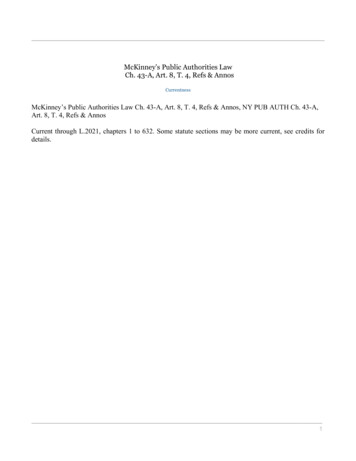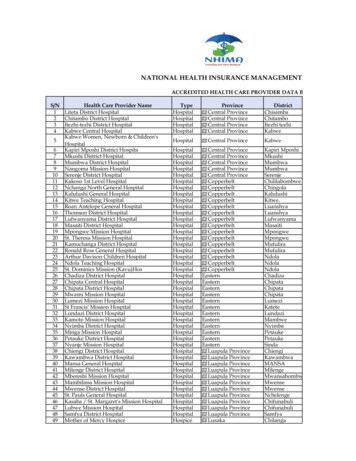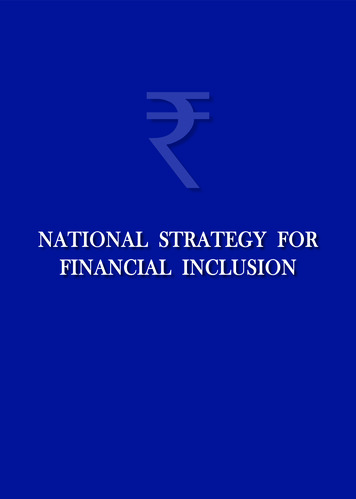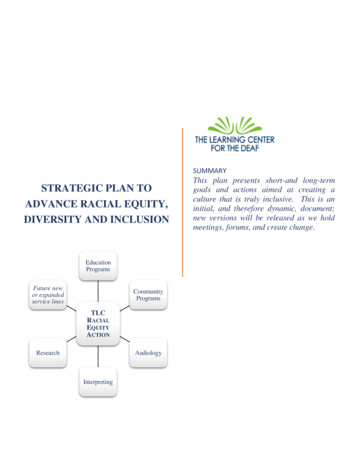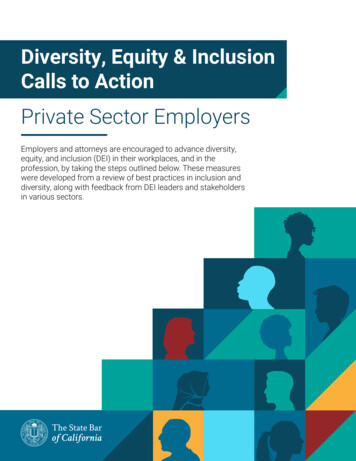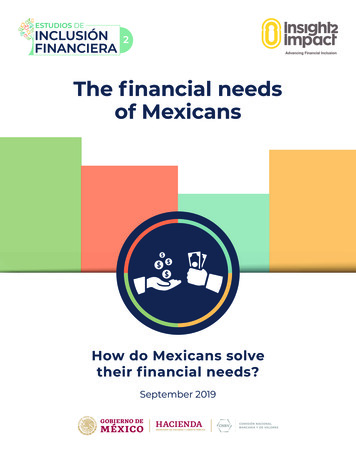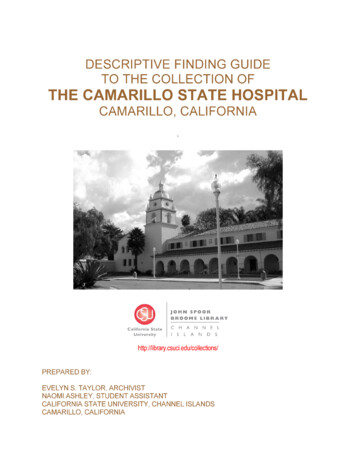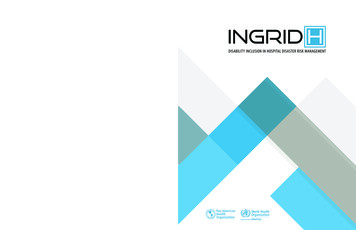
Transcription
DISABILITY INCLUSION IN HOSPITAL DISASTER RISK MANAGEMENT
DISABILITY INCLUSION IN HOSPITAL DISASTER RISK MANAGEMENTWashington D.C. 2018
Also published in SpanishInclusión para la gestión del riesgo de desastres en hospitalesISBN: 978-92-75-32052-5Disability inclusion in hospital disaster risk managementISBN: 978-92-7512052-1 Pan American Health Organization 2018All rights reserved. Publications of the Pan American Health Organization are availableon the PAHO website (www.paho.org). Requests for permission to reproduce or translatePAHO Publications should be addressed to the Communications Department through thePAHO website (www.paho.org/permissions).Suggested citation. Pan American Health Organization. Disability inclusion in hospitaldisaster risk management. Washington, D.C.: PAHO; 2018.Cataloguing-in-Publication (CIP) data. CIP data are available at http://iris.paho.org.Publications of the Pan American Health Organization enjoy copyright protection in accordance with the provisions of Protocol 2 of the Universal Copyright Convention.The designations employed and the presentation of the material in this publication do notimply the expression of any opinion whatsoever on the part of the Secretariat of the PanAmerican Health Organization concerning the status of any country, territory, city or area orof its authorities, or concerning the delimitation of its frontiers or boundaries.The mention of specific companies or of certain manufacturers’ products does not imply thatthey are endorsed or recommended by the Pan American Health Organization in preferenceto others of a similar nature that are not mentioned. Errors and omissions excepted, thenames of proprietary products are distinguished by initial capital letters.All reasonable precautions have been taken by the Pan American Health Organization toverify the information contained in this publication. However, the published material is being distributed without warranty of any kind, either expressed or implied. The responsibilityfor the interpretation and use of the material lies with the reader. In no event shall the PanAmerican Health Organization be liable for damages arising from its use.II
CONTENTSPreface . VAcknowledgments.VIIAcronyms. IXGlossary of term.XIntroduction. 1Chapter 1: Objectives, limitations, and methodology. 3Objectives. 3Specific objectives. 3Limitations. 3Methodology used in designing INGRID-H. 4Chapter 2: Inclusion in disaster risk management. 5Key principles of disability-inclusive disaster risk management. 6Universal accessibility. 6Equality and nondiscrimination. 9Ethnic and cultural diversity. 9Participation. 9Gender perspective. 9Inclusion begins with recognizing the term. 10Operational framework for the inclusion of persons with disabilitiesin hospital disaster risk management. 10Types of disability. 12III
INGRID-H DISABILITY INCLUSION IN HOSPITAL DISASTER RISK MANAGEMENTChapter 3:Disability Inclusion in Hospital Disaster Risk Management (INGRID-H). 13Preparedness for hospital emergency and disaster response, with emphasison persons with disabilities. 13INGRID-H methodological cycle. 14Preparatory activities for application of the INGRID-H methodology. 19Familiarization with and presentation of the INGRID-H methodology. 19Formation of the INGRID-H task force. 31Training program. 21Evaluation using the INGRID-H index. 22Documentary evaluation. 22Evaluation of the facility. 22Results obtained by implementing INGRID-H. 23Scenario A: autonomy and response capacity. 25Scenario B: autonomy, but with low response capacity. 25Scenario C: response capacity, but with low autonomy. 25Scenario D: low autonomy and low response capacity. 25Report on INGRID-H findings. 26Preparation of the basic action plan. 27References. 28Annexes . 31Annex 1: Suggested basic components for the inclusion of personswith disabilities in the hospital emergency plan. 31Annex 2: Suggestions for inclusive simulations and drills. 33Simulation. 33Drill. 34Annex 3: Suggested form for identifying persons with disabilities. 37IV
PREFACEINGRID-H— Disability Inclusion in Hospital Disaster Risk Management —is an “evaluation- action” methodology intended to improve the level of inclusion of people with disabilities inhealth disaster risk management, particularly in hospital preparedness and response to emergencies and disasters.This technical resource is developed in three chapters. Chapter 1 highlights the objectives ofINGRID-H, the limits of the study and the methodology used for its calculation. Chapter2 corresponds to a necessary conceptualization of Inclusion for Disaster Risk Management(INGRID), its principles and its operational framework. Chapter 3 focuses on the methodological cycle for the application of INGRID-H, which allows the development of a step-by-stepprocess based on three phases:The first is evaluation, in which a baseline is established on the current level of inclusion ofpeople with disabilities in hospital response preparedness for emergencies and disasters, andleads to the creation of an action plan for the continuous improvement in inclusion for disasterrisk management.The second phase is implementation, which is divided into three steps:a) Visibility and participation activities, that aim to improve in the short term (30 days)visibility and representation of people with disabilities in the hospital.b) Autonomy activities, that aim to improve at the medium- and long-term conditions thatallow people with disabilities to perform autonomously in the hospital.c) Strengthening response capacity activities, that aim to improve preparedness for response,particularly the updating of procedures in the hospital plan for response to emergenciesand disasters, so that it includes the specific needs of people with disabilities.The third phase is verification, where actions are established with the objective of assessingthe disability variable in the hospital emergency and disaster response plan, through inclusivesimulation exercises and simulations.The implementation of INGRID-H will not only contribute to the fulfillment of the rights ofpeople with disabilities, but will also contribute to the efforts of the countries to have a safer,more inclusive and resilient health sector.V
ACKNOWLEDGMENTSThe “Disability Inclusion in Hospital Disaster Risk Management” (INGRID-H) methodologywas developed and carried out through a participation process, focused on the rights and needsof people with disabilities in emergency and disaster situations.The Pan American Health Organization would like to acknowledge all the people and organizations that participated in this process, and those who have directly intervened in the revision ofthe INGRID-H methodology.Special mention goes to the professionals from Chile, Ecuador and Mexico who participated inthe pilot and revision phases, at the following hospitals:CHILE:Ministry of Health of ChileDra Eloiza Diaz de la Florida HospitalPeñaflor HospitalECUADOR: Ministry of Public HealthEnrique Garcés HospitalAmbato Teaching General HospitalRiobamba Teaching General HospitalSan Vicente de Paúl HospitalHospital for Comprehensive Care of Older AdultsAlbert Gilbert Pontón HospitalMÉXICO:Mexican Social Security Institute*Specialties HospitalOncology HospitalCardiology HospitalPediatrics Hospital* Siglo XXI National Medical Center. High specialty medical unitsVII
INGRID-H DISABILITY INCLUSION IN HOSPITAL DISASTER RISK MANAGEMENTThe development of this methodology and its tools, as well as the implementation of solutions in the pilot phase, has been possible thanks to the financial support of the Departmentof Health and Human Services of the United States (HHS).Authors: Alex Camacho Vásconez, Roddy Camino, Ciro Ugarte, and Juan Carlos Sánchez.Technical contribution: Alejandro Santander, Felipe Cruz Vega, Armando Vásquez, Francisco Guevara, Leonardo Hernández, Antony Duttine, Yocelyn Price, César Intriago, AndreaPacheco, Manuel Minaya, Rafael Castillo, Jean Marc Gabastou, Carlos Kaiser, and DianaPacheco.Technical coordination: Alex Camacho Vásconez and Roddy Camino.Editorial coordination: Alex Camacho Vásconez, Rosario Muñoz and Juan Carlos Sánchez.Design and layout: Victor Ariscaín.VIII
ACRONYMSCRPD: Convention on the Rights of Persons With DisabilitiesICF: International Classification of Functioning, Disability and HealthINGRID (formerly DIRR): Disability Inclusion in Disaster Risk Management (Spanishacronym for Inclusión para la gestión del riesgo de desastres)INGRID-H: Disability Inclusion in Hospital Disaster Risk Management (Spanish acronymfor Inclusión para la gestión del riesgo de desastres en hospitales)PAHO/WHO: Pan American Health Organization / World Health OrganizationIX
INGRID-H DISABILITY INCLUSION IN HOSPITAL DISASTER RISK MANAGEMENTGlossary ofTERMSAccessibility. The combined constituents of the constructed space that allow for access,movement, and use by people with disabilities. This includes modifications of furniture tomeet the needs of people with different types and degrees of disability (1).Accessible emergency route. The uninterrupted and obstacle-free evacuation paththat provides a route from any point of a building to a public street. It includes vertical andhorizontal paths and safe areas (10).Autonomy. A condition that allows persons with disabilities to perform actions independently, without the physical or communications environment being a source of vulnerability during a disaster.Capacity. The combination of all the strengths, attributes and resources available within acommunity, society, or organization that can be used to achieve agreed goals (2).Chain of accessibility. The set of elements that, as the user interacts with the constructed environment, permit the activities planned in that environment to take place—in otherwords, the elements that allow movement from a starting point to a destination to unfoldsmoothly and without a break for all people (4).Disability. Refers to impairments, activity limitations, and participation restrictions.Disability is the interaction between individuals with a health condition (e.g. cerebral palsy,Down syndrome and depression) and personal and environmental factors (e.g. negative attitudes, inaccessible transportation and public buildings, and limited social supports) (5).Disaster risk management. The systematic process of using administrative directives,organizations, and operational skills and capacities to implement strategies, policies, and improved coping capacities in order to lessen the adverse impacts of hazards and the possibilityof disaster (2).Disaster. A serious disruption of the functioning of a community or a society involvingwidespread human, material, economic or environmental losses and impacts, which exceedsthe ability of the affected community or society to cope using its own resources (2).X
Hospital emergency and disaster committee. This is the body within a hospital thatis responsible for articulating, directing, evaluating, and coordinating the hospital’s activitiesbefore, during, and after an emergency or disaster, with the participation of all of the staff—also known as the emergency risk management committee (6).Hospital emergency and disaster response plan. A hospital’s documentedmulti-hazard plan to respond to emergencies and disasters that has been systematically examined and updated, and that defines the measures to be taken before, during, and after anytype of emergency or disaster that the hospital may face (6).Inclusive risk management. Management activities that address and attempt to correct or reduce existing disaster risk, taking into account population groups in conditions ofvulnerability (2).International Classification of Functioning, Disability and Health (ICF). TheICF classifies and codes disabilities based on the impairments, activity limitations, and participation restrictions associated with them (5).Performance level. This refers to the outcomes that show the dynamism of people’s activities regardless of their capacities (8).Person with disabilities. Any person with a physical, mental, or sensory deficiency,whether permanent or temporary, that limits the capacity to perform one or more essentialeveryday activities, and that can be caused or aggravated by the economic or social environment (5).Rebuilding. Medium- or long-term sustainable reconstruction and restoration of the vitalinfrastructure, services, dwellings, facilities, and livelihoods necessary for the full functioningof a community or society affected by a disaster, following the principles of sustainable development and “rebuilding better” in order to prevent or reduce the risk of future disasters (2).Recovery. Recovery or improvement of livelihoods and health, as well as the goods, systems, and activities (economic, physical, social, cultural, and environmental) of a communityor society affected by a disaster, following the principles of sustainable development and“rebuilding better” in order to prevent or reduce the risk of future disasters (2).Rehabilitation. Reestablishment of the basic services and facilities needed for the functioning of a community or society affected by a disaster (2).Response. The provision of emergency services and public assistance during or immediately after a disaster in order to save lives, reduce health impacts, ensure public safety and meetthe basic subsistence needs of the people affected (2).XI
INGRID-H DISABILITY INCLUSION IN HOSPITAL DISASTER RISK MANAGEMENTRisk management. The systematic approach and practice of managing uncertainty tominimize potential harm and loss (2).Risk. The combination of the probability of an event and its negative consequences (2).Signage. This is the information provided for orientation and information, whether inauditory, visual, symbolic, or tactile form (11).Technical aids. Technological and material devices that make it possible to enable, rehabilitate, or compensate for one or more functional, motor, sensory, or intellectual limitation ofpersons with disabilities (3).Threat. A human process, phenomenon, or activity that can cause death, injury, otherhealth effects, damage to goods, social disruption, or economic or environmental harm (2).Universal design. The concept of creating products and environments designed to be usableby all people to the greatest extent possible, without need of adaptation or specialization (7).Visibility. In order to conceptualize the dimensions involved in analyzing Disability Inclusion in Disaster Risk Management (INGRID), visibility is defined as an organization’s abilityto identify, recognize, and arrange for the specific needs of persons with disabilities.Vulnerability. The characteristics and circumstances of a community, system, or materialasset that makes it vulnerable to the harmful effects of a hazard (2).XII
INTRODUCTIONThe impact of disasters is greater in the Western hemisphere than anywhere in the worldexcept the Asian continent. Around a quarter (21%) of all disasters occurring in the worldbetween 2008 and 2017 took place in the Region of the Americas, creating 254,334 victims,and causing damage equivalent to approximately US 592 billion. The most common eventswere water- and weather-related, representing 6% of deaths and 79% of injuries in thisperiod (12). In addition to hydrological and meteorological events, seismic activity, volcaniceruptions, landslides, and events such as fires and social disturbances, among others, can havemajor effects on populations, infrastructure, and elements such as health services, which areessential for providing care during and after emergencies and disasters.The Sendai Framework for Disaster Risk Reduction 2015-2030 declares it urgent and essentialto predict disaster risk, plan measures, and reduce risk in order to protect people. Moreover, riskreduction practices should reflect a broader preventive approach that considers hazards frommultiple perspectives, such as multisectorality, inclusiveness, and accessibility; and they shouldfocus on actions such as monitoring, evaluating, and understanding disaster risk (13). Similarly, comprehensive plans should be adopted that promote inclusion, efficient use of resources,mitigation of climate change, and resiliency in the face of disaster situations (14).The purpose of the all-inclusive and accessible approach is to reduce the risks that disproportionately affect populations in conditions of vulnerability and, particularly, people withdisabilities, as reflected in greater mortality, morbidity, and difficulty in disaster situations(15). The fact that people with disabilities are usually excluded from disaster risk management policy-making and planning (13) increases their vulnerability and creates difficultiesin responding to victims after a disaster. For all of these reasons, efforts should be made toinclude people with disabilities and their families in disaster risk management, and greateremphasis should be placed on preparedness for emergency and disaster response, especially inessential areas like health.It is essential to have health facilities whose services, in the immediate wake of an emergencyor disaster, remain accessible, and whose operations remain functional at their maximuminstalled capacity with the facilities’ usual infrastructure (6). This means that health workersshould be prepared to respond to all types of threats, on the “leaving no one behind” prin-1
INGRID-H DISABILITY INCLUSION IN HOSPITAL DISASTER RISK MANAGEMENTciple; this includes workers, patients and their family members, and victims of events, andrelies on all of a facility’s elements. Moreover, health facilities’ infrastructure should make itpossible for people with disabilities to go about their business autonomously, i.e., facilitiesshould comply with regulations on universal access and universal design.In supporting the efforts of the countries’ health sectors to comply with article 11—“Situations of risk and humanitarian emergencies”—of the United Nations Convention on theRights of Persons with Disabilities (CRPD), this document presents a methodology forfostering inclusiveness in hospital disaster risk management, with attention to the needs ofpersons with disabilities (16). The methodology has been titled Disability Inclusion in Hospital Disaster Risk Management, using the Spanish acronym INGRID-H.2
CHAPTER 1:Objectives, limitations,and methodologyOBJECTIVESThe objective of INGRID-H is to improve the level of training in hospitals for responding toemergencies and disasters due to any type of event (natural phenomena; biological, chemical,or radiological threats; armed conflicts and other hazards of a social nature), with an emphasis on persons with disabilities in the hospital setting.SPECIFIC OBJECTIVES To facilitate the capacity of persons with disabilities to receive information, move, orevacuate themselves independently, without the physical or communications environmentmaking them vulnerable to potential disasters (autonomy). To promote the strengthening of hospital capacities—by means of equipment, procedures, and trained personnel—to support persons with disabilities who are unable to actautonomously during an emergency or disaster. To identify critical points and decision-making, through an index that reflects health facilities’ level of inclusion and establishes actions to create short-, medium- and long-termimprovements.LIMITATIONSThe INGRID-H methodology is designed for health personnel working in disaster risk management, as well as personnel in public and private hospitals at the local, subnational, andnational levels.Although the methodology has been designed to reduce disaster risks for persons with disabilities working in health facilities, it also helps facilities address the needs of others, such aspatients and visitors.3
INGRID-H DISABILITY INCLUSION IN HOSPITAL DISASTER RISK MANAGEMENTWhile INGRID-H was designed for use in hospitals with over 100 beds, it can also be applied to low-complexity health care facilities.METHODOLOGY USED IN DESIGNING INGRID-HINGRID-H was designed with both qualitative and quantitative methods, and included: A review of literature on the rights, vulnerabilities, and specific needs of persons withdisabilities during emergencies or disasters. Workshops with experts on disaster risk management and disability, in designing theevaluation variables and qualitative basis for measurement. These experts included personswith disabilities. Pilot studies at hospitals in Chile, Ecuador, and Mexico, which were used in completingthe design. Set theory for quantitative assessment of the hospital disaster risk management index.The index is constructed based on a number of evaluation parameters (items), groupedand categorized in five areas: (1) visibility of persons with disabilities; (2) participation ofpersons with disabilities; (3) universal access; (4) response capacities developed; and (5)hospital emergency and disaster response plan.Each item is evaluated—as to whether it is exclusive, probably inclusive, or inclusive—using parameters that have been established previously through qualitative means, with aspecific weight given to each item, based on the evaluator’s observations.In order to assure that the assessment of an item is located within one of the sets of results, an order of priority was first established for each evaluation parameter. For example,under “Visibility,” one of the items deals with the availability of information on personswith disabilities working in the institution. Within this item, the evaluation parametersincluded the availability of data such as age, gender, type of disability, workplace location,etc., and the parameters were ranked within the item and within the area of evaluation.Finally, to calculate the overall index, each area and evaluation item was individuallyweighted by experts to determine its contribution to the overall value.4
CHAPTER 2:Inclusion in disasterrisk managementSeveral ways of referring to the inclusion of people with disabilities have arisen since 2013. Inorder to standardize concepts in this and future publications, the term ‘INGRID’ has beenadopted as the acronym for Disability Inclusion in Disaster Risk Management (2). INGRIDis the Spanish acronym for Inclusión para la Gestión del Riesgo de Desastres.INGRID involves using disaster risk reduction policies and strategies to prevent new risks(prospective disaster risk management) to mitigate existing disaster risks (corrective disasterrisk management), and to manage residual risk that cannot effectively be reduced. This callsfor preparedness, response, and recovery activities (compensatory disaster risk management),while considering the needs and participation of persons with disabilities at the same level ofpriority as the general population, in order to be fully compliant with the CRPD (2, 16).INGRID is gaining increasing strength, and is being given the importance it merits in thepolicies, plans, and projects of governments, civil society, international agencies, etc. As previously mentioned, it is important to enhance the visibility and participation of persons withdisabilities by implementing universal access and by eliminating barriers to information andcommunication. This paves the way for responding to emergencies and disasters in a way thattakes account of the needs of persons with disabilities (17, 18).All these policies, plans, and projects are of urgent importance, since persons with disabilitiescan be affected disproportionately in emergency situations and their specific needs have oftennot been taken into account. Indeed, it has been shown that mortality among persons withdisabilities in disaster situations is two to four times higher than among the disability-freepopulation (19).5
INGRID-H DISABILITY INCLUSION IN HOSPITAL DISASTER RISK MANAGEMENTIn 2013, a worldwide United Nations survey on disability and disasters pointed to severalcritical issues (20): Persons with disabilities stated that they are rarely consulted on their needs, i.e., information on their needs has not been gathered. Lack of universal access limits and impedes the ability of persons with disabilities to adequately communicate and receive information. This also hinders the evacuation process. Preparedness, response, and recovery plans do not include measures to address the needsof persons with disabilities.These critical issues can be addressed based on a number of principles, which constitute thefoundation of INGRID.KEY PRINCIPLES OF DISABILITY-INCLUSIVE DISASTER RISK MANAGEMENTAlthough the United Nations Convention on the Rights of Persons with Disabilities andthe Sphere Humanitarian Charter (21) establish several general principles in this area, it isimportant to emphasize five key principles and how they are applied in disability-inclusivedisaster risk management. The principles that should be invoked in all phases of disaster riskmanagement are:Universal accessibilityKEYPRINCIPLESEquality and non-discriminationEthnic and cultural diversityParticipationGender approachUniversal accessibilityThis is the criterion that should be met by all goods, services, environments, processes, tools, objects, products, and devices, to ensure they can be safely, autonomously, and easily understood and used by all people. The framework of universalaccessibility requires that all of the above be conceived or planned from the start,as well as used, by all people to the greatest extent possible (1).6
In all infrastructure works—and specifically in the design, planning, construction, and remodeling of health facilities—the chain of accessibility should be preserved. This means thatmovement between a starting point and a destination is feasible continually and without interruption for all people, and particularly for those with limited mobility. The elements thatmake up this chain of accessibility in hosp
Hospital emergency and disaster response plan. A hospital's documented multi-hazard plan to respond to emergencies and disasters that has been systematically ex-amined and updated, and that defines the measures to be taken before, during, and after any type of emergency or disaster that the hospital may face (6). Inclusive risk management.

